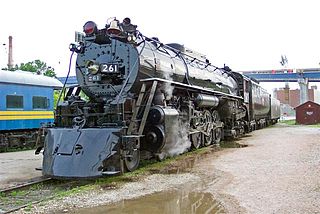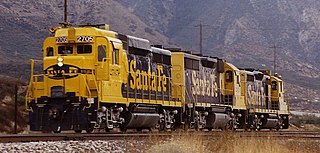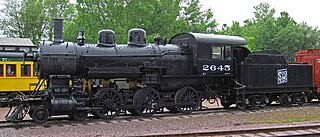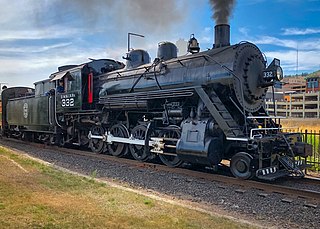
Milwaukee Road 261 is a class "S3" 4-8-4 "Northern" type steam locomotive built by the American Locomotive Company (ALCO) in Schenectady, New York in July, 1944 for the Milwaukee Road.

The Soo Line Railroad is the primary United States railroad subsidiary of the Canadian Pacific Railway, one of seven U.S. Class I railroads, controlled through the Soo Line Corporation. Although it is named for the Minneapolis, St. Paul and Sault Ste. Marie Railroad (MStP&SSM), which was commonly known as the Soo Line after the phonetic spelling of Sault, it was formed in 1961 by the consolidation of that company with two other CP subsidiaries: The Duluth, South Shore and Atlantic Railway, and the Wisconsin Central Railway. It is also the successor to other Class I railroads, including the Minneapolis, Northfield and Southern Railway and the Chicago, Milwaukee, St. Paul and Pacific Railroad. On the other hand, a large amount of mileage was spun off in 1987 to Wisconsin Central Ltd., now part of the Canadian National Railway. The Soo Line Railroad and the Delaware and Hudson Railway, CP's other major subsidiary, presently do business as the Canadian Pacific Railway. Most equipment has been repainted into the CP scheme, but the U.S. Surface Transportation Board groups all of CP's U.S. subsidiaries under the Soo Line name for reporting purposes. The Minneapolis headquarters are located in the Canadian Pacific Plaza building, having moved from the nearby Soo Line Building.

The EMC E3 is a 2,000 horsepower (1,500 kW), A1A-A1A passenger train locomotive that was manufactured by Electro-Motive Corporation of La Grange, Illinois. The EMC demonstrator #822 was released from La Grange for test on September 12, 1938. The cab version, or E3A, was manufactured from September 1938 to June 1940, and 17 were produced. The booster version, or E3B, was manufactured in March 1939 and September 1939, and 2 were produced. The 2,000 hp (1,500 kW) was achieved by putting two 1,000 horsepower (750 kW), 12-cylinder, model 567 engines in the engine compartment. Each engine drove its own electrical generator to power the traction motors. The E3 was the fourth model in a long line of passenger diesels of similar design known as EMD E-units.

The EMD GP30 is a 2,250 hp (1,680 kW) four-axle diesel-electric locomotive built by General Motors Electro-Motive Division of La Grange, Illinois between July 1961 and November 1963. A total of 948 units were built for railroads in the United States and Canada, including 40 cabless B units for the Union Pacific Railroad.

The E8 was a 2,250-horsepower (1,678 kW), A1A-A1A passenger-train locomotive built by General Motors' Electro-Motive Division (EMD) of La Grange, Illinois. A total of 450 cab versions, or E8As, were built from August 1949 to January 1954, 447 for the U.S. and 3 for Canada. 46 E8Bs were built from December 1949 to January 1954, all for the U.S. The 2,250 hp came from two 12 cylinder model 567B engines, each driving a generator to power the two traction motors on one truck. The E8 was the ninth model in the line of passenger diesels of similar design known as EMD E-units. Starting in September 1953, a total of 21 E8As were built which used either the 567BC or 567C engines.

The EMD FP7 is a 1,500 horsepower (1,100 kW), B-B dual-service passenger and freight-hauling diesel locomotive produced between June 1949 and December 1953 by General Motors' Electro-Motive Division and General Motors Diesel. Final assembly was at GM-EMD's La Grange, Illinois plant, excepting locomotives destined for Canada, in which case final assembly was at GMD's plant in London, Ontario. The FP7 was essentially EMD's F7A locomotive extended by four feet to give greater water capacity for the steam generator for heating passenger trains.

The EMD SW1 is a 600-horsepower (450 kW) diesel-electric switcher locomotive built by General Motors' Electro-Motive Corporation between December 1938 and November 1953. Final assembly was at EMD's plant at LaGrange (McCook) Illinois. The SW1 was the second generation of 3,402 cu in (55.75 L) switcher from EMD, succeeding the SC and SW. The most significant change from those earlier models was the use of an engine of EMD's own design, the then-new 567 engine, here in 600 hp (450 kW) V6 form. 661 locomotives of this design were built, with a gap in production between March 1943 and September 1945 due to World War II.

The SD45 is a six-axle diesel-electric locomotive built by General Motors Electro-Motive Division between 1965 and 1971. It has an EMD 645E3 twenty-cylinder engine generating 3,600 hp (2,680 kW) on the same frame as the SD38, SD39, SD40, and SDP40. As of 2022, most SD45s have been retired, scrapped or rebuilt to SD40-2 standards.

The ALCO RS-1 was a 4-axle diesel-electric locomotive built by Alco-GE between 1941 and 1953 and the American Locomotive Company from 1953 to 1960. ALCO subsidiary Montreal Locomotive Works built an additional three RS-1s in 1954. This model has the distinction of having the longest production run of any diesel locomotive for the North American market. The RS-1 was in production for 19 years from the first unit Rock Island #748 in March 1941 to the last unit National of Mexico #5663 in March 1960.

The Lake Superior Railroad Museum is a railroad museum in Duluth, Minnesota, United States.

The North Shore Scenic Railroad is a heritage railroad that operates between Duluth and Two Harbors, Minnesota, United States, along 28 miles (45 km) of the Lakefront Line, once part of the Duluth, Missabe and Iron Range Railroad.

Soo Line 2719 is a 4-6-2 "Pacific" type steam locomotive built by the American Locomotive Company (ALCO) for use on passenger trains operated by the Minneapolis, St. Paul and Sault Ste. Marie Railway. No. 2719 was used to haul the Soo Line's last steam-powered train, a June 21, 1959 round-trip excursion between Minneapolis, Minnesota and Ladysmith, Wisconsin. It was then displayed in Eau Claire, Wisconsin until 1996. It was restored and operated in excursion service from 1998 until 2013 when its boiler certificate expired. Today, the locomotive remains on display in Duluth, Minnesota.

Included in this list of Soo Line locomotives are those of the Minneapolis, St. Paul and Sault Ste. Marie Railroad, as well as those of the Wisconsin Central Railway, which it inherited on its lease in 1909. The M.St.P.&S.Ste.M. finally merged the WC and the Duluth, South Shore and Atlantic Railway on December 30, 1961 to form the Soo Line Railroad. The Soo Line later acquired the Milwaukee Road and became part of the Canadian Pacific Railway.

The Escanaba & Lake Superior Railroad is a Class III shortline railroad that operates 347 miles (558 km) of track in Northeastern Wisconsin and the Upper Peninsula of Michigan. Its main line runs 208 miles (335 km) from Rockland, Michigan, to Green Bay, Wisconsin, and it also owns various branch lines and out-of-service track. In 1897, the Escanaba River Company built a seven-mile (11 km) railroad from Wells, Michigan to tap a large hardwood timber stand at LaFave’s Hill. In 1898, the company name was changed to the Escanaba & Lake Superior Railway (E&LS).

Duluth & Northeastern 28 is a preserved 2-8-0 "Consolidation" type steam locomotive built in 1906 by the Pittsburgh Works of American Locomotive Company (ALCO) in Pittsburgh, Pennsylvania. It was restored to operating condition by the Lake Superior Railroad Museum from 2011-2017 and now operates in excursion service on the North Shore Scenic Railroad.

Soo Line 700 is a restored EMD GP30 diesel locomotive originally owned by the Soo Line Railroad. It was built in 1963 as a part of the "second generation" diesel power that replaced older locomotives. It is now owned by the Lake Superior Railroad Museum for use on their North Shore Scenic Railroad.

Erie Mining Company 4211 is a restored F9A diesel locomotive originally owned by the private rail company Erie Mining.

Northern Pacific 3617 is a restored SD45 diesel locomotive originally owned by the Northern Pacific. It was built in 1967 to replace older locomotives that were "trade-ins" for new units in the 1960s. Since 2007, NP 3617 has resided at the Lake Superior Railroad Museum, and was restored to operational condition in March 2021.

Great Northern 400, nicknamed Hustle Muscle, is a restored SD45 diesel locomotive originally owned by the Great Northern (GN). It was built in 1966 as the first production SD45 by Electro-Motive Division.

Duluth and Northern Minnesota No. 14 is a preserved MK class 2-8-2 light "Mikado" built by the Baldwin Locomotive Works for the Duluth and Northern Minnesota Railroad in 1913. In 1919, the D&NM declared bankrupt, and the locomotive was sold to the Michigan-based Lake Superior and Ishpeming Railroad, to operate there as No. 22. It was renumbered back to 14 in 1923. In 1959, No. 14 was sold to the Inland Stone Division of Inland Steel Company, another Michigan-based corporation, and it operated there until 1966. In 1974, it was transferred to the Duluth, Missabe and Iron Range Railway, and then it was donated to the Lake Superior Railroad Museum in 1981. The locomotive was restored to operation for use on the museum's North Shore Scenic Railroad between 1992 and 1998. As of 2022, No. 14 remains on static display inside the museum in Duluth, Minnesota.





















